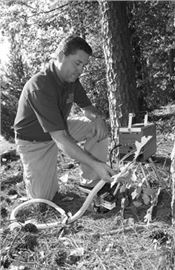Nov. 17 Online Field Tour Focuses On Upland Hardwood Management

Forestry researcher Kyle Cunningham measures light falling on an oak leaf in the understory.
Taken September 2013.
U of A System Division of Agriculture photo by Mary Hightower
LITTLE ROCK, ARK.
The Nov. 17 Virtual Upland Hardwood Management Tour for Woodland Owners will examine management of economically important white oaks, oak regeneration, and use of herbicides and prescribed fire as forest management tools.
The virtual tour will be broadcast from 1 p.m.-3 pm. with content filmed in research plots at the Livestock and Forestry Research Station near Batesville. The tour will also have question-and-answer breaks with Kyle Cunningham, associate professor of forestry for the University of Arkansas System Division of Agriculture, and Mike McGowan, research forester for the Division of Agriculture.
To register, call the station at 870-793-7432, or through http://bit.ly/VirtualHardwoodTour.
There is no cost to attend this online field tour.
The tour is geared for family forest landowners, forest managers, wildlife biologists, and others.
Attendees will learn “forest management methods developed from our research and management on the station to help them achieve personal goals for their woodlands,” Cunningham said. “These methods will include prescribed fire, vegetation control and harvest methods to promote healthy and productive upland hardwood forest types.”
The agenda includes:
• What does it take to regenerate oaks?
• How to evaluate your woodland.
• Herbicides and prescribed fire as management tools.
• Virtual site tours of natural regeneration harvests on Division of Agriculture stations.
Cunningham said part of the meeting would focus on management for white oaks – Quercus alba.
“White oak is one of the most important upland hardwood species in Arkansas. It’s much desired for its timber, wildlife, aesthetic, recreational and environmental values. Current demand for white oak logs is driving stumpage prices up,” Cunningham said. “While this is a good thing for woodland owners, we must make sure we are implementing sustainable management of the species, while capturing the value of the current demand,” he said. ∆